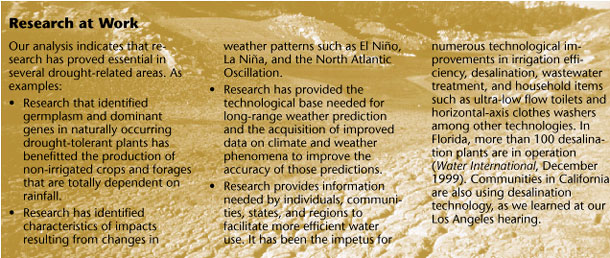Insurance is one approach
that individuals can choose to take on their own. The Small Business
Administration noted that business interruption insurance is available
in private insurance markets. However, it is generally not tailored to
the needs of small businesses in drought situations. Small businesses
may also lack access to information about the financial and business
management strategies available to them.
Insurance has been a
central feature of U.S. agricultural policy for decades. And while
farmers and ranchers are also among the first to feel the impacts of
drought, the federal crop insurance program, as noted earlier, covers
only major field crops, not all vegetable and other crops in all
locations or livestock.
A variety of strategies
were offered for the Commissionís consideration. Some were variations
on the crop insurance program but with emphasis on self-help, extended
coverage, resource stewardship, and preparedness. Many have been and are
being discussed in a variety of forums, including the U.S. Congress.
In-depth analysis of these strategies would require much more time and
many more resources than were available to the Commission. We therefore
endorse none of the approaches but present the following summary.
 |
One
approach called for incorporating all crops and livestock into the
crop insurance program and for taking a "whole-farm"
approach to insurance. That means losses from one crop or one type
of livestock could be offset by gains in a different crop or type
of livestock on the same farm.
|
 |
Another
approach discussed at the Commissionís hearings in Austin,
Atlanta, and Billings would replace the current crop insurance
program with one based on the cost of production. Under this
program, all crops and livestock would be included on a whole-farm
basis. The federal government would subsidize premiums, but at
different rates than under the current program.
Payments would be made when income is less than 90% of the
documented cost of production. Paid premiums would be maintained
in a national trust fund for disbursement.
|
 |
A
third option was to base crop insurance payments on the same
criteria used to make direct payments to farmers for resource
conservation measures under the Conservation Security Program
proposed in the Administrationís 2001 budget. The objective is
to recognize stewardship of farm and range lands and water on
farms and ranches, which are valuable assets in addition to the
crops and livestock raised on those lands.
|
 |
In
counties of Florida, Michigan, Massachusetts, and several other
states where farmers often produce a variety of specialty crops,
the Department of Agriculture is testing the Adjusted Gross
Revenue model. This
Return
to Table of Contents | (continue) |
|

